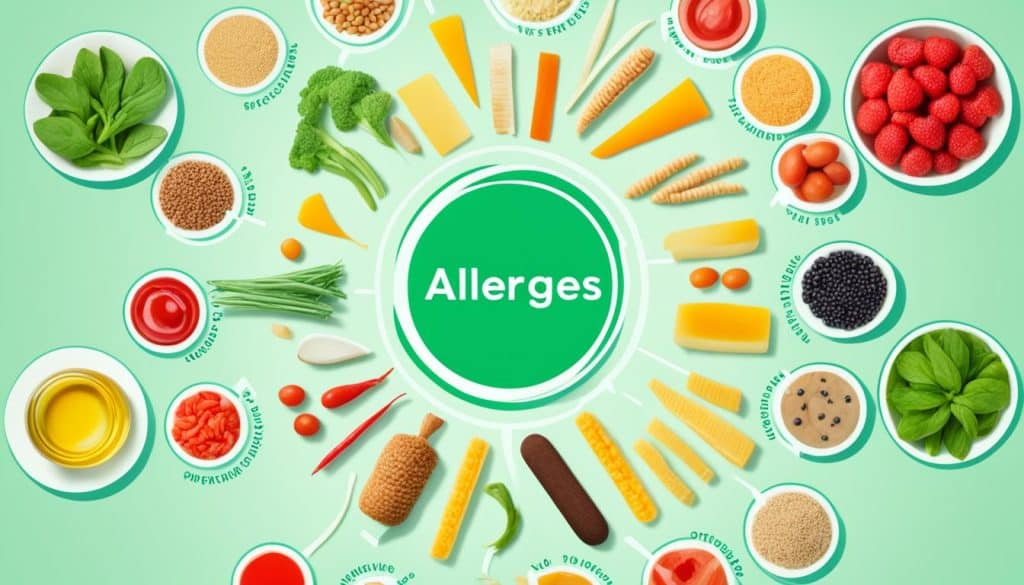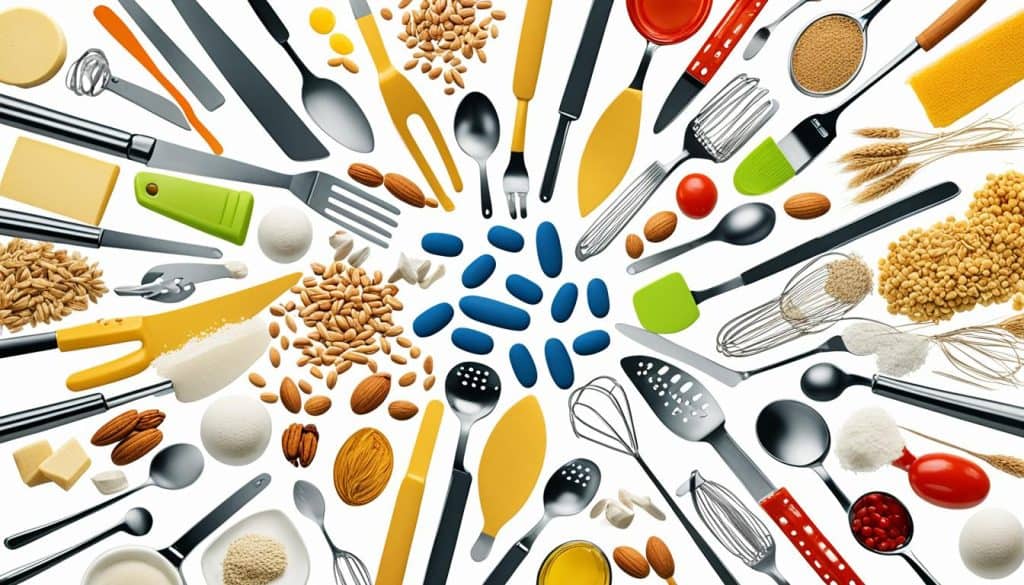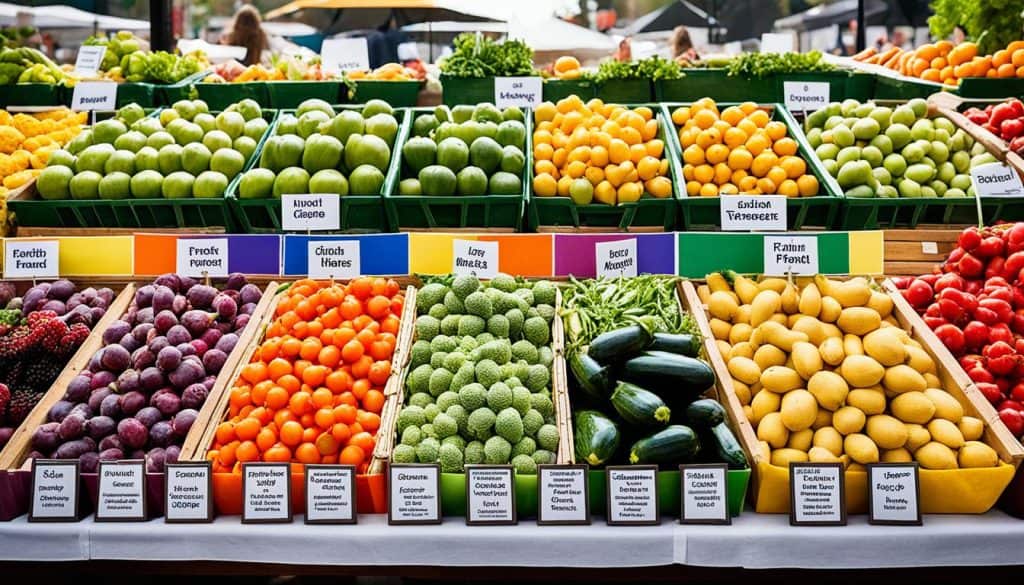Living with food allergies can be tough, but it doesn’t mean you can’t enjoy your meals. With the right knowledge and tools, cooking for allergies can be both safe and tasty. Let me tell you a story that sets the stage for our journey into allergy-friendly cooking.
Meet Sarah, a young professional who found out she has food allergies. She loves cooking and trying new things in the kitchen. But, she was worried about giving up her favorite dishes. Determined to keep enjoying food safely, Sarah started looking for allergy-friendly recipes and ways to cook.
Her search led her to allergy-friendly cookbooks and online resources. She found that March is National Nutrition Month, a great time to focus on healthy and tasty cooking. Sarah was thrilled to discover cookbooks like “Cook It Up: Delicious Recipes for Healthy Cooking.” These books had recipes without milk, egg, peanut, and tree nuts.
Sarah checked out an online recipe blog at www.cook-it-up.com/blog. There, she found lots of allergy-friendly recipes from a registered dietitian and allergy experts. The recipes fit different diets and clearly listed allergens, making it easy for Sarah to find what she needed.
Sarah was impressed by the variety of recipes she found. There were snacks, main dishes, and even desserts without allergens. The blog also had a forum where she could talk with others, share recipes, and get advice.
As Sarah explored allergy-friendly cooking, she learned important tips. She learned to always check food labels carefully because ingredients can change. She also realized it’s key to use separate tools to avoid mixing allergens.
Through her journey, Sarah saw that cooking for allergies doesn’t have to be hard or dull. With some creativity and planning, she could make delicious meals safely. Whether it was finding allergy-friendly ingredients, substituting allergens, or planning meals, Sarah found cooking for allergies rewarding.
Key Takeaways:
- Food allergies don’t have to restrict your culinary experiences.
- Allergy-friendly cookbooks and online resources offer a wealth of recipes and support.
- Whole foods like fruits, vegetables, and proteins are readily available in most grocery stores.
- An allergy-safe kitchen is crucial for preventing cross-contamination.
- Consistent label reading and using separate utensils are essential safety measures.
Understanding Food Allergies
Food allergies have become more common, affecting many people. When someone has a food allergy, their immune system overreacts to certain food proteins. This can cause mild to severe symptoms.
Common food allergens include milk, eggs, peanuts, tree nuts, fish, shellfish, wheat, soy, and sesame. These can cause reactions like hives, itching, swelling, trouble breathing, or stomach issues.
Knowing how food allergies work is key to managing them. When a person with a food allergy eats an allergen, their immune system sees it as a threat. This leads to the release of chemicals that cause allergic symptoms.
People with food allergies need to know how to avoid allergens. Food labels must list common allergens clearly. But, allergens can still be present through cross-contact.
To avoid cross-contact, it’s important to take steps. This means making your kitchen safe, reading labels carefully, and finding allergy-friendly foods and recipes.
Preventing Cross-Contact and Accidental Allergen Exposure
Cross-contact means allergens move from one food to another, causing accidental exposure. To lower this risk, follow these tips:
- Keep separate areas in your kitchen for safe foods to avoid mix-ups with allergens.
- Wash your hands well with soap and water before touching safe foods to remove allergens.
- Clean surfaces, utensils, and tools before and after use to prevent allergen transfer.
- Use separate utensils and tools for safe foods and foods with allergens.
- Wash dishes and utensils in hot, soapy water before use to remove allergens.
- Tell household members to wash their hands after touching or eating allergens to keep your home safe.
By following these steps, people with food allergies can lower their chance of accidental exposure and allergic reactions.

Creating an Allergy-Safe Kitchen
Cross-contamination is a big worry in kitchens that are safe for allergies. This happens when allergens move from one thing to another, which can be dangerous for people with food allergies. To keep your kitchen safe and free from allergens, you need to follow safety steps and use the right tools.
Cleaning well is key to stopping cross-contamination. Before making food for someone with allergies, clean all surfaces, tools, and gear. Chef Joel J. Schaefer, with lots of experience in product development and special diets, says cleaning well is crucial to avoid mixing allergens.
It’s also key to use different utensils for safe and unsafe foods. This way, you lower the chance of accidentally touching allergens. This makes cooking safer for people with food allergies.

Restaurants and food places can also lower cross-contamination risks. Training staff on food allergies and giving out ingredient lists for dishes are important steps. Also, having special areas and gear for making food for people with allergies is a good idea to keep allergens away from safe food.
Using tools made for allergens, like purple knives and boards, can also help. These tools remind you to keep safe and unsafe foods apart. This makes the kitchen safer and cuts down on the risk of accidental exposure.
By following safety steps like cleaning well, using separate tools, and allergen-specific gear, you can make your kitchen safe for allergies. Keeping safety first and stopping cross-contamination is key for a safe and welcoming space at home or in a food place.
Shopping for Allergen-Free Ingredients
Shopping for allergen-free ingredients is easier with a good allergen-free food shopping guide and knowing how to read labels. Food allergies are more common now, so it’s key to know about hidden allergens and cross-contamination risks.
People with food allergies should always carry an epinephrine auto-injector, like an EpiPen, for emergencies. Some might also consider immunotherapy to lessen their allergic reactions.
When looking for allergen-free ingredients, reading labels carefully is crucial. Food labels must list all ingredients. But, allergens might be hidden under different names. An allergen-free food shopping guide can help by listing common allergens and their hidden names.
“May contain traces of…” or “Manufactured on equipment that also processes…” warn of cross-contamination risks. These warnings are important for people with food allergies.
Shopping for allergen-free ingredients often means finding products for specific diets. Recipes for allergies often use ingredients without wheat, dairy, or fish. This helps people avoid common allergens.
The top 8 allergens include milk, eggs, peanuts, tree nuts, fish, shellfish, soy, and wheat. But, some products might avoid other allergens like sesame, potato, casein, and sulfites. Always check the ingredient list to be sure a product is safe.
Finding allergen-free products like granola bars can be tough. But, there are more options now, like dairy-free yogurt, gluten-free bake mixes, and almond butter.
Some allergen-free products are made for kids, like animal crackers and almond butter. These options let kids with allergies enjoy safe and tasty snacks.

Buying from single-source ingredient providers is a good idea for allergen-free shopping. These providers focus on reducing cross-contamination risks by using ingredients from dedicated facilities.
Some allergen-free products also have less sugar or special flavors. These can be great for people who want healthier options but still want to enjoy their food.
Allergen-free foods might cost more than regular foods. But, they offer peace of mind and safety for people with food allergies, making them a good choice.
Allergen-free ingredients can be found in many stores. Big box stores, chain grocery stores, and health food stores carry a lot of allergen-free products.
Online shopping makes it easy to buy allergen-free products, like bread, from home. This saves time and gives access to more allergen-free ingredients.
Knowing how to shop for allergen-free ingredients and reading labels carefully helps people with food allergies. This way, they can choose products safely and meet their dietary needs.
Allergy-Friendly Recipes
Cooking for allergies doesn’t mean you have to give up flavor and variety. There are many allergy-friendly recipes out there. They include gluten-free, dairy-free, and vegan options. These recipes are made by experts to be safe and tasty for everyone.
Masterchef Canada 2017 finalist, Thea VanHerwaarden, and Canadian race car star Alex Tagliani worked together on these recipes. They created a collection of dishes that are both diverse and delicious.
Linda Kirste, a Registered Dietitian, helped make sure the recipes are healthy. She worked with Thea to make sure the recipes are safe for allergy sufferers and are balanced nutritionally.
The recipe list includes favorites like Donairs, Green onion cakes, and Double chocolate banana bread. There are also Açaï Bowl, Sushi, Chicken tacos with mango salsa, and chickpea avocado crema. These dishes show how allergy-friendly food can be creative and tasty.
Health Canada has given tips on food allergens and substitutes. These substitutes are similar in nutrition or function in cooking. This helps keep the recipes safe for allergies while still tasting great.
There are also tips for setting up a healthy diet for kids with food allergies. You’ll find advice on avoiding cross-contamination and keeping food fresh. These tips make cooking for allergies easier.
Adult bloggers and Nestlé Canada share their allergy-friendly recipes and tips too. Some recipes may have allergens, but they can be adapted for your needs. Always check the ingredients to make sure they’re safe.
These allergy-friendly recipes are great for many diets. Most people with allergies face challenges with common foods like dairy and nuts. But gluten is also a big concern for those with gluten sensitivities.
To be gluten-free, a food must not have gluten and avoid cross-contamination with other grains. This ensures that people with gluten sensitivities can enjoy the recipes safely.
All the recipes here are free from the top 8 allergens. This means they’re good for people with multiple food sensitivities. The recipes include a wide range of meals, from appetizers to desserts.
Some recipes offer special alternatives for different diets or beliefs. For example, you can use turkey instead of pork for religious reasons. This way, everyone can enjoy tasty meals that fit their needs.
There are also many dessert options. You can make gluten-free pumpkin donuts or dairy-free banana ice cream. These desserts show that allergy-friendly food can still be delicious and fun.
These recipes use safe ingredients like coconut aminos and SunButter. These ingredients make sure everyone can enjoy tasty foods without worrying about allergies.
There are over 300 allergy-friendly recipes to try. They’re organized by meal type, making it easy to find something for any time of day. This makes cooking for allergies easy and fun.
There are also tips for using both homemade and store-bought allergy-friendly products. This lets you customize your meals to your liking.
To keep up with new recipes and newsletters, you can sign up for a newsletter. Subscribers get updates in their inbox, so they never miss out on new dishes.
Meal Planning for Allergies
Meal planning is key when you have food allergies. It helps you make balanced meals that fit your diet. With more people having food allergies, it’s hard to find ready-made foods that are safe. So, many people cook all their meals themselves.
Planning meals for allergies can be tough, especially if you’re short on time or don’t know much about cooking without allergens. It can also lead to cooking the same things over and over. That’s why adding variety and creativity to your meal planning is important.
Meal planning can help. It saves time and money and makes sure you have a variety of safe meals. At Heart of Cooking, you can find over 1000 recipes that are free from allergens for different diets.
Heart of Cooking has special menu planners for different diets. Each week, members get a new planner with a shopping list to make grocery shopping easier.
WayFare Health Foods also focuses on allergies in their meals. They avoid the top 10 common food allergens, including dairy, wheat/gluten, eggs, and more.
Choosing ingredients wisely and prepping meals ahead are key to good meal planning for allergies. Using ingredients in multiple meals saves time and reduces waste. Freezing meals adds flexibility to your planning.
When planning meals, think about nutrition and managing your lifestyle. Use some of your favorite recipes and change them up every 2-3 weeks. Stick to simple recipes for breakfast during the week and save the fun ones for the weekend. Using leftovers for lunch makes cooking easier.
Make a list of your family’s favorite foods and make sure meals have a mix of food groups. This helps everyone eat well and meet their dietary needs.
For personalized help with allergen-free diets, Heart of Cooking offers consultations. They even have a free 20-minute session to help you start cooking without allergens.
By using meal planning and the resources available, you can make eating with allergies easier. You can enjoy tasty, balanced meals that fit your needs.
Allergy-Friendly Desserts
It’s easy to satisfy your sweet tooth while cooking for allergies. There are many allergy-friendly dessert recipes out there. You can make your own dairy-free ice cream with safe ingredients. Enjoying tasty desserts is a great way to indulge safely.
There are many allergy-friendly dessert recipes to try. They use ingredients safe for people with food allergies. For instance, flax seeds can replace eggs, and vegan butter can stand in for regular butter.
These desserts are not only safe but also full of flavor. You can find recipes for everything from chocolate cake to lemon cookies. There’s even a recipe for chocolate avocado pudding that’s refreshing.
For more ideas, check out the Enjoy Life’s Cookies for Everyone cookbook. It has over 150 recipes that are gluten-free and safe for allergies. The book includes recipes without gluten, wheat, peanuts, tree nuts, eggs, dairy, and soy. You’ll find everything from allergy-friendly brownie bites to apple crisp.


